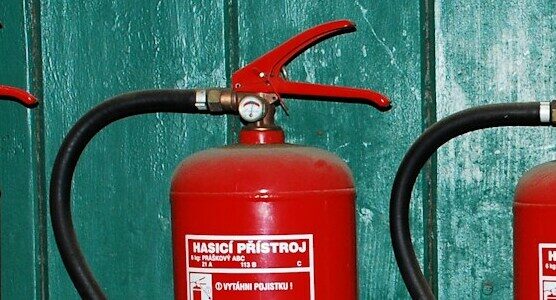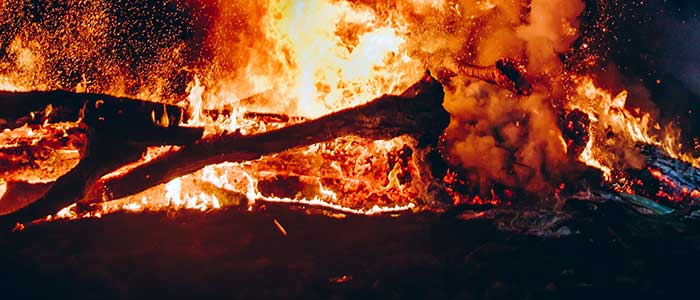Dashpivot Article – OSHA Fire Safety Regulations
OSHA Fire Safety Regulations
Read on to understand your OSHA fire safety regulations and requirements, as well as how to best manage these requirements.

OSHA Fire Safety Regulations: A requirement
The US government agency Occupational Safety and Health Administration (OSHA) regulates workplace health and safety. It sets and enforces workplace safety and health regulations and provides training, outreach, information, and support to companies to ensure worker safety and health. One important component is OSHA's fire safety rules. Fire is beneficial yet may destroy lives and property.
The National Fire Protection Association (NFPA) data shares that the US fire departments have responded to 36,784 industrial or manufacturing fires (including utility, defence, agricultural, and mining facilities) annually from 2017 to 2021.
These fires caused 22 human fatalities, 211 civilian injuries, and $1.5 billion in direct property damage annually. As part of its mission, OSHA continuously provides a solution to eliminate such incidents and establishes fire safety regulations to limit workplace fire threats.
OSHA Fire Safety Regulations
This set of regulations is designed to handle any potential dangers that may be present in the general industry. We will go through each aspect of all the regulations that are necessary for OSHA to build fire safety in your workplace.
Exit Routes
As per OSHA 1910.35, the employer is required to demonstrate compliance with the exit-route provisions of NFPA 101, Life Safety Code, 2009 edition, or the exit-route provisions of the International Fire Code, 2009 edition, to be in compliance with the corresponding requirements in 1910.36 and 1910.37.
The 1910.36 subsection explains the design and construction requirements of exit routes. It states the following requirements in this section:
- An exit must be separated by fire-resistant materials
- Openings into an exit must be limited.
- The number of exit routes must be adequate
- Exit discharge must lead directly outside or to a street
- An exit door must be unlocked.
- A side-hinged exit door must be used.
- The capacity of an exit route must be adequate.
- An exit route must meet minimum height (2.3 m) and width (71.1 cm at all points) requirements.
- An outdoor exit route is permitted.
The 1910.37 subsection on the OSHA Fire Safety requirements lays out the maintenance, safeguards, and operational features for exit routes. Here are the features that must be present in your exit routes:
- The danger to employees must be minimized
- Lighting and marking must be adequate and appropriate
- The fire-retardant properties of paints or solutions must be maintained
- Exit routes must be maintained during construction, repairs, or alterations
- An employee alarm system must be operable
Emergency Planning
The 1910.38 explains the requirements inside an emergency action plan. It is highly emphasized in 1910.38(b) that an emergency action plan must be in writing, kept in the workplace, and available to employees for review. However, an employer with 10 or fewer employees may communicate the plan verbally to employees. It also provided the minimum requirements of an emergency action plan, which are procedures for reporting a fire or other emergency, procedures for emergency evacuation, procedures to be followed by employees who remain to operate critical plant operations before they evacuate, procedures to account for all employees after evacuation, procedures to be followed by employees performing rescue or medical duties, and the name or job title of every employee who may be contacted. This section also explains that an employee alarm system must always be available, the necessity of training the personnel to the procedures stated above, and the regular review of the emergency action plan. To know more about this, read more at OSHA Emergency Action Plan.
Hazardous Materials
OSHA has recognised the hazardous materials that are a fire hazard to the work environment. OSHA 1910 subpart H is a dedicated section that listed all the fire hazards in the workplace. The following are the materials that OSHA listed as a fire hazard: compressed gases, acetylene, hydrogen, oxygen, flammable liquids, spray finishing using flammable and combustible materials, and explosives and blasting agents. Since these materials play an important part in the processes in the general industry, OSHA has created the following procedures to eliminate the possibility of a fire: storage and handling of liquefied petroleum gases, storage and handling of anhydrous ammonia, process safety management of highly hazardous chemicals, and hazardous waste operations and emergency response.
OSHA Fire Safety Regulations for Fire Protection
OSHA 1910 subpart L contains requirements for fire brigades and all portable and fixed fire suppression equipment, fire detection systems, and fire alarm systems installed to meet the fire protection requirements of 29 CFR part 1910.
Fire Brigades (1910.156) : This section governs fire brigade organisation, training, and PPE when founded by an employer. This section applies to fire brigades, industrial, and private/contractual fire departments. Only firefighters combating inside structure fires must wear PPE. The employer must prepare and maintain a statement or written policy establishing the existence of a fire brigade, its basic organisational structure, the type, amount, and frequency of training to be provided to members, the expected number of members, and its workplace functions. The Assistant Secretary and workers or their representatives may examine the organisational statement.
Portable Fire Extinguishers (1910.157): The requirements of this section pertain to the positioning, use, upkeep, and testing of portable fire extinguishers that are made available for usage by staff members. This section also covers the following: the general requirements, selection, distribution, inspection, maintenance, testing, and types of fire extinguishers. Additionally, the employer is required to give an educational programme to workers in addition to providing portable fire extinguishers for employees to use in the workplace. The purpose of this programme is to familiarise employees with the basic principles of fire extinguisher usage as well as the risks that are associated with fighting fires in their early stages.
Standpipe and Hose Systems (1910.158): Every single small hose, Class II, and Class III standpipe system that has been installed in order to fulfil the criteria of a specific OSHA standard is subject to the provisions of this section. According to OSHA, the employer is responsible for ensuring that standpipes are either situated in a secure location or otherwise secured from mechanical harm. Repairs must be made as soon as possible for damaged standpipes. The following pieces of equipment are required to be in compliance with this regulation: reels and cabinets, home outlets and connections, hoses, nozzles, and a suitable supply of water. The Occupational Safety and Health Administration (OSHA) maintains that all of the built-in standpipe and hose systems in the workplace should be subjected to routine inspections and maintenance.
Automatic Sprinkler Systems (1910.159): This section's criteria are applicable to all automated sprinkler systems that are installed in accordance with a specific OSHA standard. For automatic sprinkler systems that were installed before the standard's effective date and were used to satisfy OSHA regulations, compliance with the National Board of Fire Underwriters (NBFU) or National Fire Protection Association (NFPA) standard that was in force at the time of the system's installation will be accepted as compliance with this section.This section outlines and highlights the following regulatory requirements on automatic sprinkler systems: water supply, hose connections for fighting, sprinkler system design, maintenance, acceptance testing, pipe protection, sprinkler spacing, water source, sprinklers, sprinkler alarms, and systems with hydraulic designs.
Fixed Extinguishing System (1910.160): This section covers all fixed extinguishing systems installed to satisfy an OSHA requirement except automated sprinkler systems, which are covered by 1910.159.This section also applies to fixed systems not built to satisfy an OSHA requirement but that may expose personnel to extinguishing agent-related injury, death, or health problems. Fixed extinguishing system components and chemicals must be authorised for the fire threats they manage or suppress. Employees who inspect, maintain, operate, or repair fixed extinguishing systems must be trained and reviewed yearly to stay current. Employers must establish an emergency response plan under Section 1910.38 for areas protected by a complete flooding system with agent concentrations above acceptable limits. The employer should install and link an authorised fire detection device to a pre-discharge employee alert system to automatically activate complete flooding systems to allow workers to safely escape the discharge area before system discharge.
Fire detection systems (1910.164): All OSHA-compliant automated fire detection systems fall under this clause. The employer must ensure that all devices and equipment built and installed to this standard are authorised for their intended use. The employer must inspect and modify fire detectors and fire detection systems as required to ensure reliability and operation, except for factory-calibrated devices. Fire detectors placed outside or in corrosive environments must be safeguarded against corrosion by the employer. For weather-sensitive detecting equipment, the employer must offer a canopy, hood, or other cover. The detection system must respond within 30 seconds to fire detector alerts or devices unless it is required to protect personnel. The employer must base fire detector number, spacing, and position on design data from field experience, tests, engineering surveys, manufacturer recommendations, or a recognised testing laboratory listing.
Strategy for Reinforcing Compliance with OSHA Fire Safety Regulations
We have now fully discussed the OSHA fire safety regulations. The only thing to do now is find a way to maintain and reinforce compliance with such regulations. To do this, this kind of information must be shared first to provide everybody with awareness. Having everyone informed and educated about the regulations will be the key to compliance. The best avenue to share this information is through toolbox talks.
Toolbox talks are short, informal meetings that target safety topics and gather relevant safety issues in the workplace, which will be provided with a solution. To have an effective talk, a toolbox talk form must first be created to provide a guide for the safety topic being discussed and to record all safety issues raised. To better see what it looks like, here is an example below.
OSHA Fire Safety Regulations Toolbox Talk Example

Use this OSHA Safety Talk for Fire Safety for free
Streamlining Your Fire Safety Awareness
Handmade toolbox talks may be somewhat demanding. Since these are merely quick, informal encounters, the constant reformatting and printing may be a little disruptive. Moreover, developing the toolbox and entering the data into it calls for opening many applications—including office ones—which takes time and increases the risk of mistakes. Luckily, the Dashpivot Toolbox Talk app is an ingenious app that provided a solution to this.
You can use the Dashpivot Toolbox app with a digital toolbox discussion form produced either from a powerful form builder or a free toolbox conversation template from our template library. Employing topic tables, date pickers, digital hand signatures, or totally contactless signatures can help you to optimise your toolbox discussion form by removing the need to continually print documents and employ so many apps to convert them. Dashpivot lets you stop worrying about the internet only to fill a digital file. Starting the Toolbox Talk app right on the field offline may be your approach. Any of your ready-made or completed toolbox lectures may also be rapidly located, altered, or converted into a professionally created PDF document online, where they are automatically maintained and arranged once you have supplied content and conversation themes.
All of these and more by use of the Dashpivot Toolbox App. Click this link here to learn further: Dashpivot Toolbox Talk App.

Fire Evacuation Plan template
Use this fire evacuation plan template to create comprehensive site or project specific fire evacuation plans.

Fire Drill Report template
This fire drill report templates makes your fire drill reporting more complete and more actionable.

Fire Extinguisher Inspection Checklist template
This fire extinguisher inspection checklist makes it easier to keep your extinguishers in good, safe and compliant working order.

